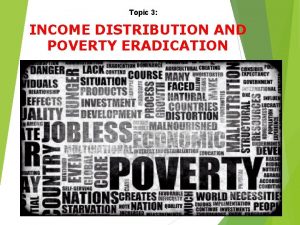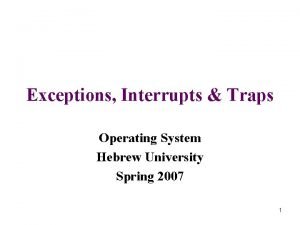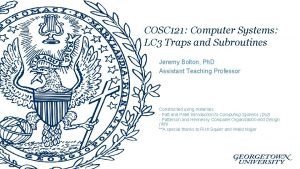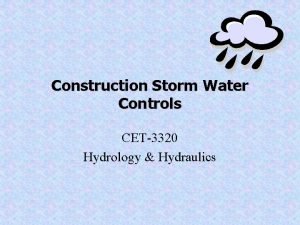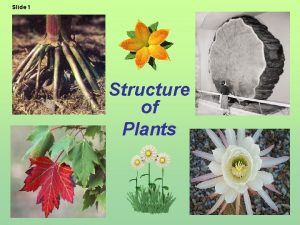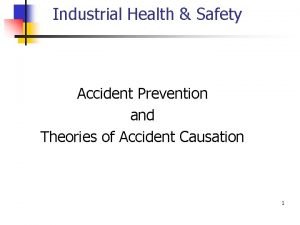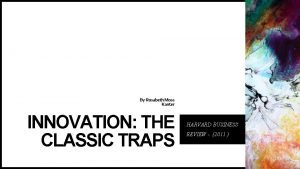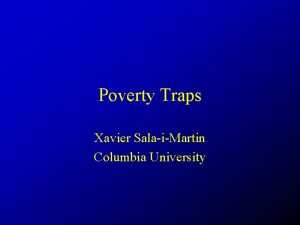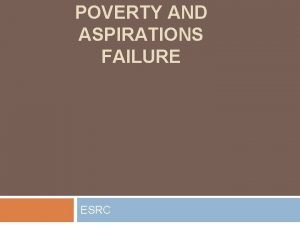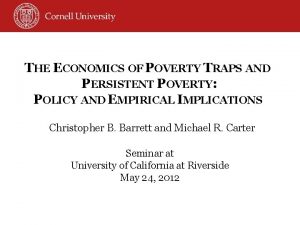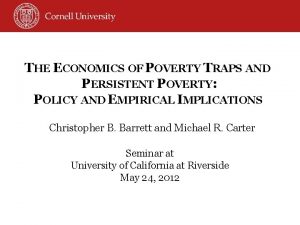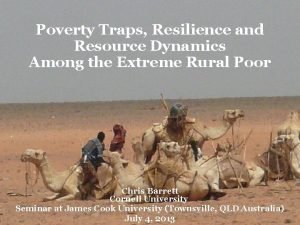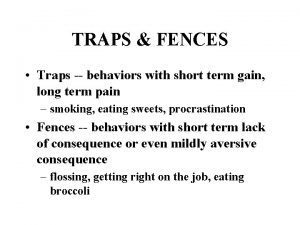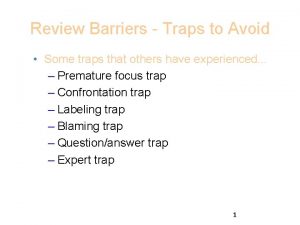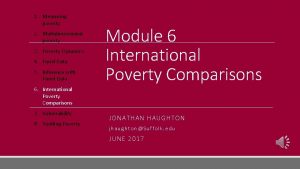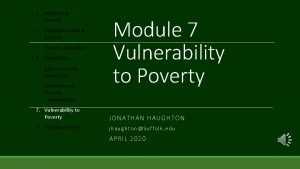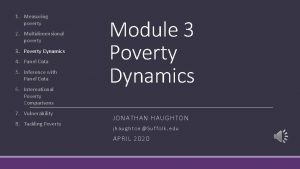APPLICATIONS OF SYSTEM DYNAMICS TO MODELING POVERTY TRAPS

















- Slides: 17

APPLICATIONS OF SYSTEM DYNAMICS TO MODELING POVERTY TRAPS AND LAND DEGRADATION IN EAST AFRICA Investigators C. BARRETT A. PELL - CORNELL B. OKUMU - CORNELL F. MURITHI - KARI F. PLACE - ICRAF J. RASAMBAINARIVO - FOFIFA

Problem Statement Agrarian poverty may create incentives to follow land livestock management practices which further reduce agricultural labor productivity by depleting natural capital: resource degradation poverty traps (RDPTs). u Key Sources of RDPTs (threshold effects): - missing/imperfect factor, product and asset markets - biologically-induced non-convex technologies






Study Objectives u Examine empirically how biological processes and market conditions interact to create or extend dynamic poverty traps u Simulate policy experiments that might sustainably reduce poverty and/or improve resource management u Build capacity with local partners to carry out such analysis and simulations locally

Better 1. North Central Kenya (Baringo) Worse MARKET ACCESS Research Design 1. Central highlands, Kenya (Embu) 2. Central highlands, Madagascar (Vakinankaratra) 1. Northern Kenya (Marsabit) Drier 1. Western Kenya (Siaya /Vihiga) 2. Southern highlands, Madagascar (Fianarantsoa) Wetter AGRO-ECOLOGICAL CONDITIONS

Research Sites Kenya Madagascar

MODEL FRAMEWORK State or decision variables HUMAN Soil/water conservation, fertilizer, brown & green manure application crop production practices land use patterns Herd size + species husbandry, feeding practices Milk meat traction Savings Manure crops, green manure LIVESTOCK Geographical effects Forage feed PLANT BIOMASS - Natural vegetation - crops Excreta, litter, - Soil cover - Soil organic matter (SOM) -Soil nutrients, - moisture SOIL -Biology (microbes, micro-fauna and flora) -Chemistry (N, P, K) - Physics (structure, texture, moisture content) ENVIRONMENTAL & POLICY FACTORS - rainfall, - temperature - slope - prices - land tenure - land use restrictions

Study Methodology u SD approach is chosen because it is consistent with traditional economic approaches towards modeling dynamic systems i. e. use of ordinary differential or difference equations u It employs a very simplified structure of feedback and causal loops that are either balancing (stable equilibrium) or reinforcing (unstable equilibrium) u It is possible to integrate or nest micro-economic models in the SD framework

Study Methodology. . . Cont’d u SD yields numerical estimates of the paths taken by key policy variables over time and space as well as any equilibrium to which they might converge (diverge) u Simulate policy experiments that might sustainably reduce poverty and/or improve resource management u Uses both quantitative and qualitative information

Rainfall ratio : Normalized rainfall for Embu 1977 -1999 Graph for rainfall ratio 2 1. 5 1 0. 5 0 1977 1981 Mean: 1270 1985 1989 Time (Year) Max: 1885 1993 1997 Min: 499

Simulation of ICRAF/KARI technologies on Soil depth levels 100 95 90 85 80 1977 1979 1981 1983 1985 1987 1989 Time (Year) 1991 1993 1995 1997 1999 Soil depth : without technology interventions cm Soil depth : with technology interventions cm

Sensitivity analysis of soil depth decline 50% 75% Soil depth 100 95% 100% 95 90 85 80 1977 1983 1988 Time (Year) 1994 1999

Policy Relevance u Models such as this one could be used to simulate policy experiments, allowing for differences according to market and agroecological conditions. For example - What are the consequences of improving market access on poverty and soils over time? - How might biological interventions (e. g. , liming soils, extending improved fallows) change labor allocation and income trajectories? - What targeting mechanisms and transfer forms (e. g. , livestock species) are likely to prove most effective in sustainably reducing agrarian poverty?
 Relative and absolute poverty difference
Relative and absolute poverty difference Traps in operating system
Traps in operating system Helen c erickson
Helen c erickson Dimensional modeling vs relational modeling
Dimensional modeling vs relational modeling How to filter crawler traps
How to filter crawler traps Social facilitation example psychology
Social facilitation example psychology Brand image trap
Brand image trap Lc3 trap
Lc3 trap Sediment traps construction
Sediment traps construction Pictionary style entrepreneurship
Pictionary style entrepreneurship Construction entrance
Construction entrance Steam traps 101
Steam traps 101 3 functions of leaves
3 functions of leaves Nursing interview techniques
Nursing interview techniques Human factor theory
Human factor theory Innovation: the classic traps
Innovation: the classic traps Traps heat shields the surface from harmful radiation
Traps heat shields the surface from harmful radiation Teen traps
Teen traps
